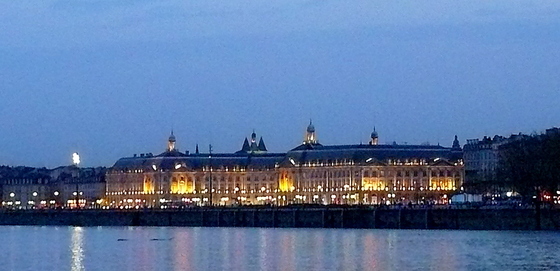
The neoclassical Place de la Bourse overlooking the Garonne River in Bordeaux.
BORDEAUX--This prosperous capital city of southwest France, known abroad for prestigious wine, built its fortunes slowly over the centuries. Yes, the vineyards surrounding the city, and the wine merchants who exported barrels of claret to England, played a major role. But there were also vast reserves of timber south of the city, and a thriving business spawning oysters in the neary Arcachon basin. Bordeaux even played a minor role in the shameful slave traffic with Haiti, an offshoot of the sugar trade. (Seattle's sister city, Nantes, was the leading port of entry.) Yet as the 20th century drew to a close, Bordeaux was in danger of becoming a grimy French Detroit, mired in conservative business views, saddled with an obsolete port and an urban infrastructure designed for a bygone era.
Best example: the dingy riverfront, lined for miles with abandoned two-story "hangars," where, before World War II, wine merchants had warehoused the wines they would ship overseas. (Times had changed; wines had been bottled at the chateaux for decades, and buyers weren't too keen on cases that had been kept in a sweltering warehouse.)
Meanwhile, the façades of Bordeaux's magnificent limestone buildings--designed in Napoleonic and neo-classical splendor--had fallen victim to disfiguring black blight. Automobile traffic, the cause of the blight, was at gridlock despite grand, Parisian-style boulevards built under Louis XV. The once-vibrant port (known as the Port of the Moon because it occupied a semicircular bend in the river) dried up, outclassed by the container yards of Le Havre, Rotterdam and Antwerp.
Then, in the 1990s, a new mayor, Alain Juppé, came along, as did a new willingness to shake things up.
First order of business: clean up the buildings. Not all at once, but street by street, house by house. (Not easy, not cheap, and, alas, not permanent.) Next, an ambitious tramway system that tore up the downtown core and half a dozen neighboorhoods for the better part of a decade. Finally, tearing down the riverfront warehouses and replacing them with, well, nothing. A broad expanse of public riverfront, three or four miles long, with bike and roller-blading lanes (and a new bike-sharing program, too), and plenty of pedestrian amenities. Next come several lanes of traffic in each direction, with a bit of parking here and there as well as turning lanes. Room for the tramway tracks, of course, and some feeder lanes. Then the magnificent architecture of the Old City.
The result is stunning. The only similar project on the west coast is in Portland, where the Tom McCall Waterfront esplanada runs along the downtown waterfront. (Seattle and San Francisco both have tourist-oriented waterfront piers which would be very difficult to remove, even though the views would be breathtaking.) What the Bordelais have instead are magnificent views of their own city now, along with efficient public transportation. The result won approval from UNESCO as well: Bordeaux and the Port de la Lune (including most of the historic center, nearly 5,000 acres in all) were designated a World Heritage site in 2007.
Private cars, sad to say, seem to be the losers. Automobile traffic is no speedier than before, and there's no other way to get from the upriver end of town to the downriver end, short of taking the 40-minute beltway loop or chancing the clogged boulevards.
But the sentiment in Bordeaux is that this, finally, is the city's decade. An architectural contest is underway to build a grand monument akin to the Bilbao Guggenheim that will define the city's character for the coming century, an iconic, cultural wine center.
For his part, Juppé is still mayor of Bordeaux, though he's in Paris these days as a member of President Nicholas Sarkozy's inner circle, currently Minister of Foreign Affairs. In France, you can wear many hats at the same time. Maybe not such a bad idea. If Gary Locke, say, were also mayor of Seattle, would we have had to wait this long for an esplanade along Alaskan Way?
Note: I'm in Bordeaux for site visits and workshops sponsored by Atout France (the French tourism development agency) and Air France.
You seized the essence of Bordeaux, Ronald. I was introduced to the city just this past fall, and look forward to returning for a more comprehensive exploration. Bordeaux struck me as immensely civilized, cultured, liveable and just plain fun. The trolley is swift, frequent, clean and reasonably priced, the core of the city is vibrant with fresh energy, and the art and fashion districts are varied and accessible. Bordeaux is a sleeper, yet to be appreciated as enthusiastically and widely as it warrants.